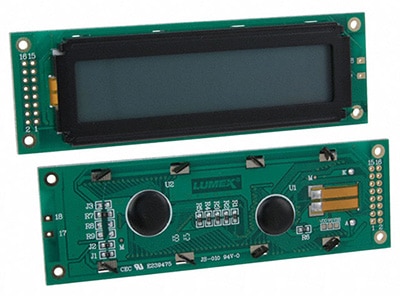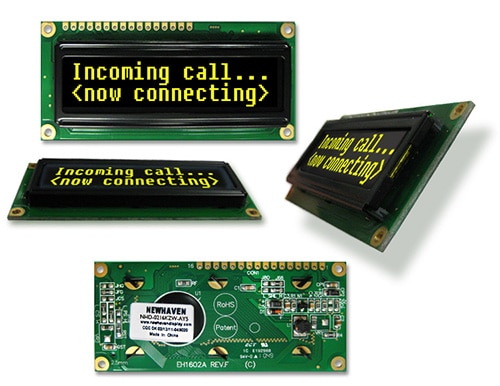Selecting LCD Modules for Extreme Temperatures
投稿人:电子产品
2014-12-02
Industrial, non-automotive transportation and military sectors, among others, often require LCD character or graphics displays that can operate in extreme temperature environments. Typically, standard LCD character and graphics modules provide a temperature range of 0°C to +50°C. However, several display manufacturers offer extreme temperature models with operating temperatures of -40°C to +80 or +85°C. There also is a wide selection of standard versions that range from -20°C to +70°C.
While the operating temperature range specification is clearly one of the most important characteristics of the display for extreme hot/cold environments, engineers also need to keep several other factors in mind when selecting a display for these applications. Some of these factors include visual display requirements, power consumption, and, of course, cost.
One of the first things that designers need to consider is the end use. The application is going to dictate the type of display required — what are the environmental conditions; what type of information will be displayed — characters (numbers or letters) or graphics — is power consumption a factor, and what performance trade-offs can be considered versus cost.
The operating environment of the LCD display — UV exposure, moisture, humidity, temperature — all of these factors are important when designing an extreme temperature display into an application, said Yasoob Ahmed, director of engineering at ITW Electronic Component Solutions.
Other factors to consider include LCD technology, display formats, and backlighting options. LCD character and graphics modules are available in several technologies, including twisted nematic (TN), super-twisted nematic (STN), and film-compensated super-twisted nematic (FSTN), which all have an impact on the color and contrast of the displays as well as cost. For example, FSTN provides the highest contrast and widest viewing angle, but it costs more than the other two options. Although the contrast is the least sharp for the TN option, it offers a faster response time and is the lowest-cost option.
“If a customer decides to use a segmented-type display with a quarter-duty cycle, then TN is okay to use,” said Ahmed. “If the duty cycle is one-sixteenth and higher then we recommend using either STN or FSTN type. STN/FSTN both offer higher contrast ratio and better view angle than TN fluid at higher duty-cycle rates.”
Designers also have a choice of display formats — reflective (requires no backlighting), transflective (can be used with or without backlighting), and transmissive (requires a backlight) — and type of backlighting (LED, EL or CFL). Each of the backlighting options has its own set of advantages/disadvantages. For example, EL backlighting enables a very thin LCD module but offers limited sizes. On the other hand, LED backlighting offers a higher brightness and easier brightness adjustment but can produce cold or hot spots.
Ahmed offers this design tip: “Depending upon what the user wants to display on the screen, if it’s numerals and icons, then go with an LCD segmented-type display. If the user wants to display characters and graphics, then we offer high-duty displays that can go from one-sixteenth to one-two-hundred and fortieth duty without compromising the performance of the display at extreme temperatures of -40°C to +85°C,” he said.
“If the display will be used during both daytime and nighttime applications, go with transflective mode. If the display will only be used during the nighttime, go with transmissive mode and if the display will only be used during daytime, go with reflective mode, which does not require a backlight,” he added.
Displays also are available in positive (dark characters on light background) or negative (light characters on a dark background) modes. Typically, a wide range of colors are available.
Let’s take a look at one of the extreme temperature range displays first. Lumex offers its InfoVue High/Low Temp series of high-duty LCD displays (such as the LCR-U02002DSF-WH) for applications that operate in extreme heat or cold. The need for the extended temperature range was driven by a variety of applications, according to Lumex, including military, freezer, gas/fuel pumps, non-automotive transportation, and non-climate-controlled facility applications.
The InfoVue High/Low Temp displays (Figure 1) operate over a wide temperature range from -40°C to +85°C while delivering enhanced visual display quality and cost as well as energy savings. The new design was achieved by developing a “special liquid crystal” that eliminated the need for large coolers and allowed for the use of low-power heaters. This design resulted in a 50 percent savings in costs and an 80 percent energy savings compared to alternative technologies such as vacuum fluorescent (VF) displays.

Figure 1: Lumex’s High/Low Temp LCD modules suit applications where displays operate in extreme heat or cold conditions, and deliver as high as an 80 percent power reduction compared with other traditional display technologies.
The InfoVue High/Low LCD displays provide full graphic capability and daylight visibility, compared to some other LCD displays that only provide alphanumeric displays in a limited number of segments and colors, according to Lumex. When used with LED backlighting, a wide range of color options are available. All of the LED backlights are specifically designed to operate from -40°C to +85°C. All of the displays are low power. The displays are available with a monochromatic screen with an LED backlight or a negative image option with mono-colored pixels and a black background. Standard character display modules available include 16 x 2 (16 characters x 2 lines), 20 x 2 (LCR-U02002DSF-WH), and 20 x 4 (LCR-U02004DSF-WH). Standard graphics display modules are available in 128 x 64 pixel and 240 x 128 pixel resolution. Customization is available.
There are also a few suppliers like Newhaven Display International and Electronic Assembly GmbH that offer extended temperature range character displays using the latest OLED technology.
Newhaven’s OLED character displays (Figure 2) are said to offer brighter and higher contrast than conventional LED and LCD displays. These character displays also offer a wide temperature range from -40°C to +80°C. Other advantages include faster response times, wider viewing angles, and lower power consumption than conventional LED and LCD displays. A few other points about the OLED displays is that they are self-illuminating and require no backlight for visibility in all environments, said the manufacturer, and they are much thinner than other standard displays.

Figure 2: The Newhaven Display NHD-0216KZW-AY5 is a 16 x 2 character yellow OLED display. The viewing angle is 66.00 mm L x 16.00 mm W. Character size is 5.55 mm H x 2.95 mm W.
The Newhaven character OLED displays are available in standard sizes, including 16 x 2 and 20 x 2, and are touted as drop-in replacements for LCD or VFD modules. They contain all the external logic components. Other features include a fast response of 10 microseconds, a viewing angle up to 160 degrees, a high contrast ratio of 2000:1, and a choice of a serial or parallel MPU interface.
Electronic Assembly GmbH also offers OLED character displays in the same high-temperature range. These devices include the EA W082-XLG (2 x 8 yellow), EA W162-X3LG (2 x 16 yellow), EA W162-X3LW (2 x 16 yellow), EA W162-X9LG (2 x 16 yellow), EA W162-XBLG (2 x 16 yellow), and EA W162-XBLW (2 x 16 yellow). Sizes vary for these 2 x 16 yellow displays. They are available in viewing areas of 66 mm or 99 mm in length and widths of 16.00 mm, 24.00 mm, or 25.20 mm.
Wide temperature range monochrome segment displays are also available. A few examples are the Varitronix VI-508 and VIM-828 displays. The 7-segment VI-508 series features an operating temperature range of -30°C to +80°C, while the 14-segment VIM-828 series offers an operating temperature range of -40°C to +80°C. Both are TN-type displays.
If the design does not call for the highest temperature range, there is a host of LCD character and graphics displays available with a temperature range of -20° to +70°C. A few examples include Newhaven’s NHD-0108-xZ displays, the Parallax 16 x 4 27979 character LCD displays, the EA DOG and EA DIP series LCD modules (STN or FSTN) from Electronic Assembly, and Kyocera’s STN or FSTN character displays (16 x 2, 20 x 2, 20 x 4, and 40 x 2).
In summary, when selecting an LCD display for an extreme temperature environment, the first thing designers need to evaluate is the operating environment — temperature, UV exposure, moisture, and humidity. They also need to consider what will be displayed on the screen — numerals and icons or display characters and graphics — and if the display will be used in daytime or nighttime applications. All these factors, together, will help select the best display for the application.
For more information on the parts discussed in this article, use the links provided to access product information page on the DigiKey website.
免责声明:各个作者和/或论坛参与者在本网站发表的观点、看法和意见不代表 DigiKey 的观点、看法和意见,也不代表 DigiKey 官方政策。





